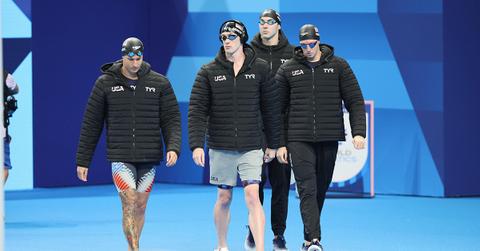Some Olympic Swimmers Come out in Winter Coats, but Why Are They Bundled Up?
Olympic swimmers wear coats to keep their body temperature high.
Published July 31 2024, 1:04 p.m. ET

Olympic swimmers are among the best athletes in the world, and if you've ever watched an athlete, you know that many of them have pretty strange routines. Sometimes, those routines serve no practical purpose and are instead part of some sort of superstition. Other times, they have real practical value.
Some have noticed that many swimmers come out to the pool wearing coats ranging from lightweight jackets to full-on winter puffers. Now, many want to know why they wear those jackets, and what purpose they serve.

Why do Olympic swimmers wear winter coats?
The reason that Olympic swimmers often come out to the pool in coats is that they want to keep their core body temperature and skin warm before a race. This is really just an extension of a swimmer's warmup routine, which is designed to make sure that muscles are ready for high levels of activity before they have to put them under immense pressure.
Once a swimmer warms up, they put their coat on so that those muscles stay warm, and they don't cool down before the race actually starts. While the sample size is small, studies suggest that athletes who come out in coats and only take them off just before the race starts perform better on average than those who wear fewer clothes piror to a race. It could have some psychological benefits too, as it helps a swimmer feel prepared.
How warm is the water for Olympic races?
The coats aren't necessarily supposed to make the shock of getting into the water any easier, but they certainly don't hurt. Olympic pools are supposed to be between 25 and 28 degrees Celcius, or between 77 and 82 degrees Farenheit. If you've ever been in a pool, you're likely aware that that's pretty warm water, although it certainly doesn't hurt to be warm when you're getting into water of any kind.
Elite swimmers are obviously used to the temperature of racing pools, though, so it shouldn't be shocking for them to feel the temperature.
Instead, coats are more of a mechanism for keeping athletes' muscles warm, especially because they are starting from a position out of the water for most strokes. In sports like running, they can run right up to the starting line to ensure that they go right from their warmup into the actual race.
Swimming, by contrast, requires athletes to warm up somewhere and then get ready to jump into the pool for the race. That additional hurdle makes it more necessary for swimmers to take steps to maintain their warmup even after they are no longer actively warming up.
That's also why they do things like get their wetsuits wet and slap their arms and legs prior to a race. They want to make sure that they are ready to go the second they enter the pool so that they don't need any warm up time during the actual race itself.